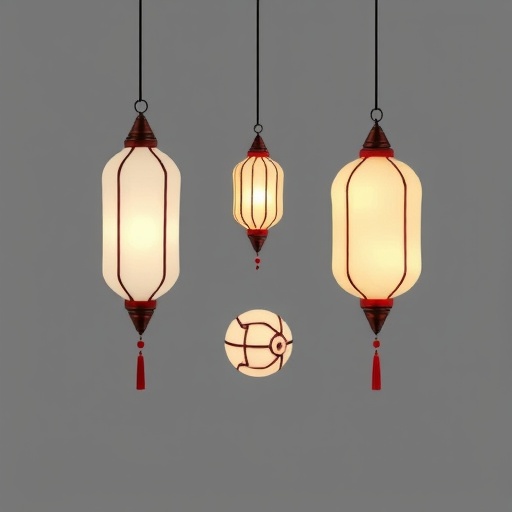Researchers at North Carolina State University have made significant strides in the field of material science by developing a remarkable polymer known as the “Chinese lantern,” which possesses extraordinary capabilities to transform into over a dozen dynamic three-dimensional shapes. This innovation leverages the principles of bistability and multistability, providing a unique avenue for applications ranging from robotics to environmental management. By utilizing a process that combines compression and twisting, these researchers have created a structure that can manipulate stored energy effectively, reflecting a conscious design that is both practical and fascinating.
The basic premise of this innovation begins with a simple polymer sheet, which is meticulously crafted into a parallelogram shape reminiscent of a diamond. Each sheet is then incised with parallel lines that extend across its center, allowing for a series of connected ribbons that maintain structural integrity through solid strips at both the top and bottom edges. This design results in a loosely spherical shape that closely resembles a traditional Chinese lantern, a clear indication of the balance between art and scientific exploration that underpins this research.
At the core of this design lies the concept of bistability, as explained by Jie Yin, a professor in mechanical and aerospace engineering at NC State. The initial lantern shape is stable, yet it possesses a hidden potential. When compressive forces are applied, the structure deforms until it reaches a critical threshold. This transition triggers a rapid snap into an alternate, stable configuration akin to that of a spinning top. Notably, this transformation is energy-efficient; as soon as the compression is released, the stored energy allows the structure to revert to its original shape in a rapid, dynamic motion.
In an extension of their findings, the team identified methods to augment the number of available shapes beyond the initial two. By introducing twists, folds in the solid strips, and various combinations thereof, the polymer can embody multiple stable forms. Each configuration exhibits multistable characteristics, which enable it to switch between states depending on external forces. Some structures can alternate between two stable forms, while others can demonstrate four distinctive stable states based on the applied forces. This breadth of possibilities showcases the engineers’ meticulous attention to object manipulation and stability.
Remarkably, the ability to control these transformations extends beyond manual manipulation. By affixing a thin magnetic film to the bottom strip of the structure, researchers demonstrated remote controllability using an external magnetic field. This feature opened up a myriad of possibilities for practical applications that leverage the structure’s ability to snap between shapes. They successfully illustrated several use cases, including a non-invasive gripper designed for capturing fish, a filter capable of modulating water flow, and a compact design that could rapidly extend into a taller formation to open a collapsed tube.
Equally intriguing is the mathematical model developed by the researchers to quantify and predict how various angles within the structure dictate both the shape and energy states of the lantern unit. This model is a critical tool, enabling engineers to program specific shapes, assess their stability, and evaluate the potential energy stored within each configuration. By focusing on these parameters, the researchers can tailor the lantern units to perform specific roles in various applications.
Looking towards the future, there is immense potential for these innovative lantern units. The next step involves assembling them into two-dimensional and three-dimensional frameworks which could serve as the basis for extraordinary advancements in shape-morphing mechanical metamaterials. Such designs possess the potential to impact fields ranging from robotics, where adaptive mechanisms are crucial, to environmental engineering, where responsive structures could address dynamic challenges.
The implications of this research reach far beyond the confines of academia, as the practicality of the Chinese lantern structure suggests a wealth of applications in industries that rely on innovative solutions to traditional problems. Whether it’s developing responsive robotics that can adapt to changing environments or creating advanced filtration systems that adjust according to real-time conditions, the direction laid out by these researchers could dynamically shift operational paradigms across multiple sectors.
In encapsulating this advancement, the publication titled “Reprogrammable snapping morphogenesis in freestanding ribbon-cluster meta-units via stored elastic energy” offers an in-depth exploration of the research findings and methodologies involved. Set to be released in the journal Nature Materials, this body of work will undoubtedly intrigue fellow researchers, industry leaders, and curious minds alike, cementing the significance of this achievement in the realm of material science and engineering.
Ultimately, this breakthrough presents a striking visualization of the possibilities when creativity meets rigorous scientific inquiry. The Chinese lantern structure serves as not just an engineering marvel but a harbinger of future advancements in material capability and functional design. With the support of organizations like the National Science Foundation, the journey towards refining these groundbreaking concepts continues, promising exciting outcomes that may redefine interactions with engineered materials in the coming years.
As the world progresses toward increasingly complex challenges that require innovative solutions, the advancements presented by these researchers will undoubtedly open doors to new technologies and applications that can transform our daily lives, showcasing the importance of scientific exploration and collaboration.
Subject of Research: Innovations in dynamic polymeric structures
Article Title: Reprogrammable snapping morphogenesis in freestanding ribbon-cluster meta-units via stored elastic energy
News Publication Date: 10-Oct-2025
Web References: http://dx.doi.org/10.1038/s41563-025-02370-z
References: Source not specified
Image Credits: Yaoye Hong, NC State University
Keywords
Polymer, shape-shifting, bistability, multistability, energy storage, robotics, materials science, responsive design, environmental engineering, metamaterials, remote control.
Tags: bistability in materials scienceChinese lantern designdynamic shape transformationenergy manipulation in structuresenvironmental management solutionsinterdisciplinary science and artmechanical engineering advancementsmultistability applicationsNC State University researchpolymer material innovationpractical applications of designrobotics applications of polymers





